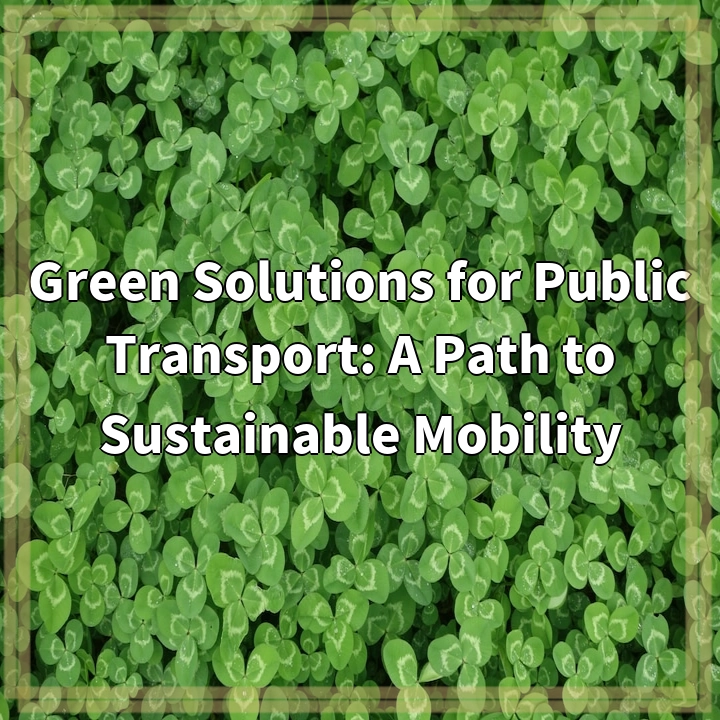
What it is:
Green solutions for public transport refer to the implementation of environmentally friendly practices and technologies in the transportation sector. It involves adopting strategies that minimize the environmental impact of public transport systems while providing efficient and affordable mobility options for people. Green solutions aim to reduce emissions, improve air quality, conserve energy, and promote sustainable urban development.
Real-World Problems Associated with Green Solutions for Public Transport:
1. Limited Infrastructure: One of the major challenges in implementing green solutions for public transport is the lack of appropriate infrastructure. This includes the absence of dedicated lanes for buses or trams, inadequate charging stations for electric vehicles, and insufficient bike lanes or pedestrian pathways. Without proper infrastructure, it becomes difficult to encourage the use of sustainable modes of transportation.
2. High Implementation Costs: Investing in green solutions for public transport often requires significant financial resources. The cost of purchasing and maintaining electric buses, installing charging stations, upgrading existing infrastructure, and implementing innovative technologies can be substantial. Securing funding and ensuring cost-effectiveness is a key challenge for many cities and transport authorities.
3. Limited Awareness and Public Support: Despite the growing awareness of the need for sustainable transportation, many people still remain unaware of the benefits of green solutions for public transport. Lack of knowledge and understanding can hinder the adoption of these initiatives. In addition, public support may also be affected by resistance to change and concerns about potential disruptions to existing transportation systems.
4. Interoperability and Integration: Integrating different modes of green public transport, such as buses, trams, and bicycles, can be challenging. Ensuring seamless connections, coordinating schedules, and providing convenient transfer points are key factors for encouraging people to opt for sustainable mobility options. Efforts to enhance interoperability are crucial for creating an efficient and user-friendly public transport network.
5. Policy and Regulatory Barriers: Policy and regulatory frameworks play a vital role in promoting and enabling the implementation of green solutions for public transport. However, outdated or conflicting policies, lack of supportive regulations, and bureaucratic hurdles can hinder progress. Addressing these barriers requires collaboration between government agencies, transport authorities, and other stakeholders.
6. Equity and Accessibility: Green solutions for public transport should be accessible and affordable for all members of society, including disadvantaged communities. Ensuring equitable access to sustainable mobility options can help reduce social inequalities and improve overall transportation outcomes.

Solutions for Green Solutions for Public Transport:
Investment in Infrastructure:
To overcome the limited infrastructure challenge, cities and transport authorities should invest in the development of dedicated lanes for buses or trams, expand charging station networks for electric vehicles, and enhance bike lanes and pedestrian pathways. By providing the necessary infrastructure, it becomes easier to encourage the use of sustainable modes of transportation.
Securing Funding and Cost-Effectiveness:
Governments and transport authorities should explore various funding options, such as public-private partnerships, grants, and subsidies, to support the implementation of green solutions. It is also essential to conduct thorough cost-benefit analyses and prioritize investments to ensure the efficient use of resources.
Education and Awareness:
Creating awareness about the benefits of green solutions for public transport is crucial. Education campaigns and information dissemination through various channels can help overcome the lack of knowledge and understanding. Engaging with the public and addressing concerns through community outreach programs and public consultations can also build public support for sustainable mobility initiatives.
Integration and Interoperability:
Improving the integration of different modes of sustainable transport is essential for providing seamless and convenient travel options. This can be achieved through better coordination of schedules, the implementation of smart transportation systems, and the establishment of well-connected transfer points.
Policies and Regulations:
Governments should review and update policies and regulations to facilitate the transition to sustainable transport systems. This includes incentivizing the use of green public transport, implementing regulations that prioritize clean technologies, and streamlining procedures to overcome bureaucratic barriers.
Economic and Social Equity:
Ensuring equitable access to green solutions for public transport is essential. This involves considering the needs and challenges of disadvantaged communities and implementing initiatives that address social inequalities. Affordable fare structures, accessible infrastructure, and targeted programs can promote inclusivity and create a more equitable transportation system.















